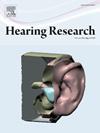Low level of expression of known deafness genes Kcne1, Kcnj10 or Col4a3 is sufficient to maintain hearing in mice
IF 2.5
2区 医学
Q1 AUDIOLOGY & SPEECH-LANGUAGE PATHOLOGY
引用次数: 0
Abstract
Kcne1, Kcnj10 and Col4a3 are all expressed in the stria vascularis where they serve critical roles in generating the endocochlear potential. Mutations in any of these three genes are linked to human deafness syndromes for which there are currently no treatments. Here, the hearing ability of three mouse lines carrying mutant alleles in these genes (Kcne1tm1a, Kcnj10tm1a and Col4a3tm1a) was investigated to assess whether they would develop an auditory phenotype similar to that of human patients. Surprisingly, all three mutant mice had normal hearing, at least up to 6 months of age, assessed by auditory brainstem response thresholds and waveforms and endocochlear potentials. Marginal cell arrangement in the stria vascularis was normal in Col4a3tm1a/tm1a mice at 8 weeks of age but showed evidence of early cellular disorganisation in Kcnj10tm1a/tm1a and Kcne1tm1a/tm1a mice. We found that the Kcne1tm1a, Kcnj10tm1a and Col4a3tm1a mutations led to incomplete knockdown of transcript, to 25 % of normal values in each case, indicating these are hypomorphic alleles. These results suggest that partial restoration of KCNE1, KCNJ10 and COL4A3 expression in patients affected by mutations in these genes may be sufficient to preserve auditory function.
已知耳聋基因Kcne1、Kcnj10或Col4a3的低水平表达足以维持小鼠的听力
Kcne1、Kcnj10和Col4a3均在血管纹中表达,它们在产生耳蜗内电位中起关键作用。这三种基因中的任何一种突变都与人类耳聋综合征有关,目前尚无治疗方法。在这里,研究了携带这些基因突变等位基因(Kcne1tm1a, Kcnj10tm1a和Col4a3tm1a)的三种小鼠系的听力能力,以评估它们是否会产生类似于人类患者的听觉表型。令人惊讶的是,通过听觉脑干反应阈值、波形和耳蜗内电位来评估,所有三只突变小鼠至少在6个月大之前都有正常的听力。8周龄时,Col4a3tm1a/tm1a小鼠血管纹边缘细胞排列正常,但Kcnj10tm1a/tm1a和Kcne1tm1a/tm1a小鼠血管纹边缘细胞出现早期紊乱。我们发现Kcne1tm1a、Kcnj10tm1a和Col4a3tm1a突变导致转录物的不完全敲低,每种情况下敲低至正常值的25%,表明这些是次形等位基因。这些结果表明,部分恢复KCNE1、KCNJ10和COL4A3基因突变患者的表达可能足以保护听觉功能。
本文章由计算机程序翻译,如有差异,请以英文原文为准。
求助全文
约1分钟内获得全文
求助全文
来源期刊

Hearing Research
医学-耳鼻喉科学
CiteScore
5.30
自引率
14.30%
发文量
163
审稿时长
75 days
期刊介绍:
The aim of the journal is to provide a forum for papers concerned with basic peripheral and central auditory mechanisms. Emphasis is on experimental and clinical studies, but theoretical and methodological papers will also be considered. The journal publishes original research papers, review and mini- review articles, rapid communications, method/protocol and perspective articles.
Papers submitted should deal with auditory anatomy, physiology, psychophysics, imaging, modeling and behavioural studies in animals and humans, as well as hearing aids and cochlear implants. Papers dealing with the vestibular system are also considered for publication. Papers on comparative aspects of hearing and on effects of drugs and environmental contaminants on hearing function will also be considered. Clinical papers will be accepted when they contribute to the understanding of normal and pathological hearing functions.
 求助内容:
求助内容: 应助结果提醒方式:
应助结果提醒方式:


